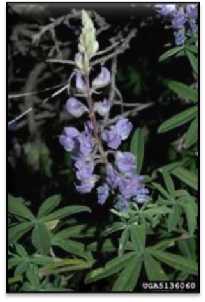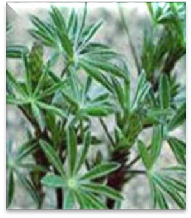Also Known as: wild pea, blue pea, quaker bonnet, bluebonnet, sundial
Lupine (Lupinus spp. L) The genus Lupinus includes hundreds of species, many native to North America.* Most Lupinus species are herbaceous perennial plants, generally growing 1 to 2 feet tall. Palmately-divided leaves are soft green to grey-green, often bearing silvery hairs. Lupine plants bloom from June to August. Flowers, each having a pea flower shape, can range in color from white to purple and occur in dense or open whorls on an erect spike. The fruit is a legume (pea pod), typically hairy, elongated and somewhat flattened, containing up to 12 seeds per pod depending upon species. The plant can fix  nitrogen from the atmosphere into ammonia, contributing to soil fertility. Lupine is adapted to a wide range of soil types, but prefers coarse-textured and well-drained soils.
nitrogen from the atmosphere into ammonia, contributing to soil fertility. Lupine is adapted to a wide range of soil types, but prefers coarse-textured and well-drained soils.
* To view species profiles, go to: http://plants.usda.gov/java/profile?symbol=LUPIN
Many species of lupine are poisonous to livestock. Sheep, cattle, and horses are most susceptible to the toxic effects. Alkaloids (primarily of the group quinolizidine) can be found in all parts of the plant, but are concentrated in the seeds. If other forage is sufficient, poisoning of livestock from lupine consumption rarely occurs. Common symptoms of lupine poisoning include salivation, agitation, dizziness, convulsions, heavy, and labored breathing, and vomiting. Sheep may appear symptomatic within 1 hour, or up to 24 hours, after eating the plant. Sheep can die after consuming 0.25% of their body weight in pods.
Photo by: William M Ciesla, Forest Health Management International, Bugwood.org
More common than poisoning, consumption of certain lupine species can cause “crooked calf” disease in pregnant range cows, particularly if consumed between the 40th and 70th days of gestation. Crooked calf disease is characterized by twisted limbs, back and/or neck, scoliosis, and occasionally cleft palates, or a combination of these deformities.
Control Methods
Physical/Mechanical: Lupine plants can be hand-pulled and dug, and are easily eradicated by cultivation although this option is often not practical since lupine is often found in open range or tree areas.
Chemical: Lupine can be managed by using several herbicides. The most effective choices are: picloram, 2,4-D, 2,4-D + dicamba, Triclopyr and metsulfuron-methyl.
More information can be found in the PNW Weed Management Handbook
USE PESTICIDES WITH CARE. Apply them only to plants, animals, or sites listed on the label. When mixing and applying pesticides, follow all label precautions to protect yourself and others around you. It is a violation of the law to disregard label directions. Store pesticides in their original containers and keep them out of the reach of children, pets, and livestock.
Biological control: Although livestock will graze lupine plants, it is important to determine toxicity of lupine plants and restrict access to them during highly toxic periods and at susceptible development stages.
Questions: contact Steve Van Vleet or phone (509) 397 – 6290
Photo credits included in PDF


